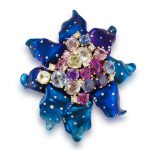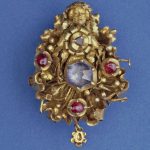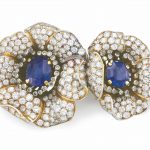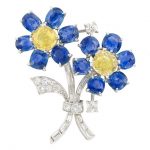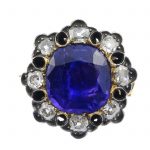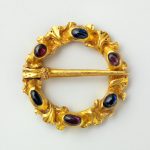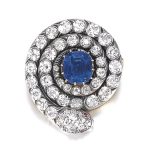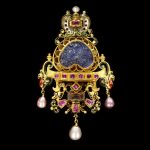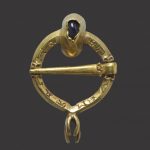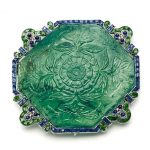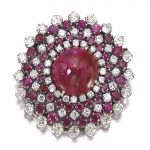Information and history of sapphires plus a gallery of sapphires used in antique and vintage brooches. The sapphire is the birthstone for September. It’s beautiful colour befits royalty so it is no wonder it was chosen as the engagement ring for Princess Diana in 1981.
Sapphire is one of the two gem-varieties of corundum, the other being ruby (defined as corundum in a shade of red). Although blue is the best-known sapphire color, they occur in other colors, including gray and black, and they can be colorless. A pinkish orange variety of sapphire is called padparadscha. Reference: Wikipedia
A Sapphire and Diamond Brooch The titanium ‘floral’ brooch set with circular-cut sapphires of various tints, accented by brilliant-cut diamonds, diamonds approx. 1.00ct total, length 5.7cm Accompanied by a Gubelin report stating that the selected natural coloured sapphires have no indications of heat treatment. Accompanied by two GIA reports stating that the sixteen natural sapphires have no indications of heat treatment and one natural sapphire undetermined.
Sold for HK$ 37,500 (£ 3,540) inc. premium at Bonhams in 2018
Cluster brooch; gold; central sapphire setting; three rubies; diamond centred on breast of female figure in robe with scalloped sleeves. She frames the central sapphire with her hands. Her figure is surrounded by beads of gold set on high stems and three rubies. Pin and loop on back. Her face and hands are keyed for white enamel of which traces can be seen on one of her cheeks. Originally there would have been two pearls, the fitting for one of which sruvives, and beads of white enamel in the pierced setting on the lower edge of the jewel.
Her face and hands are keyed for white enamel of which traces can be seen on one of her cheeks. Originally there would have been two pearls, the fitting for one of which survives, and beads of white enamel in the pierced setting on the lower edge of the jewel. Circa 15th Century
Reference: © The Trustees of the British Museum
A SAPPHIRE AND DIAMOND ‘GAUGUIN’ FLOWER BROOCH, BY VAN CLEEF & ARPELS Designed as two flowerheads, each centering upon a cushion or octagonal-shaped sapphire pistil to the curling pavé-set diamond petals, 1 3/4 ins., mounted in gold plated platinum Signed V.C.A., N.Y., no. 1578 SO (Special Order)
Sold for USD31,250 at Christies in 2018
Platinum, Yellow Sapphire, Sapphire and Diamond Flower Brooch 2 cushion-shaped yellow sapphires ap. 7.75 cts., 12 cushion-shaped sapphires ap. 18.00 cts., 13 baguette, 2 old-mine cut & 11 round diamonds ap. 1.90 cts., ap. 15.6 dwts. With copy of GIA report no. 5171815606, one yellow sapphire, ap. 3.98 cts., Sri Lanka origin, no indications of heating.
Yellow sapphires: medium yellow and bright medium deep yellow, cleanish, minor inclusions, several light scratches and minor abrasions/nicks on table edge and crown facet junctions, nice shapes and cuts, lively. One yellow sapphire has been tested, 3.98 cts., Sri Lankan origin, no indications of heating. Sapphires: medium to medium deep violet-blue, slightly included, several chips at edge and on crown facets by edge, minor table edge and facet junction abrasions, very lively. Diamonds: H-I-VS. Old-mine cut diamond: J-VS, small chip at edge, not visible to eye. Good condition. Normal wear. Measuring ap. 1 7/8 x 1 5/8 inches.
Sold for $6,250 (includes buyer’s premium) at Doyle New York in 2018
A mid Victorian silver and gold sapphire and diamond brooch. The foil-back, cushion-shape purple-blue sapphire, with old-cut diamond fleur-de-lis surround. Estimated total diamond weight 0.80ct. Length 1.9cms. Weight 6.1gms. Overall condition fair to good. Some surface scratches/ wear, discolouration and minor dents in keeping with general age and wear. Replacement pin. Diamond fairly well matched. Diamonds bright. Individual size and setting of diamonds prevents accurate colour and clarity assessment. One diamond chipped under a claw. Diamonds with small scattered dark and feather inclusions. Estimated dimensions of diamonds 3.2 by 2.8mms. Sapphire is foil-back and appears a deep bluish purple hue, well saturated, with fair clarity. Sapphire in good to fair condition with some minor scratches and nibbles to facet edges. Estimated dimensions of sapphire 11 by 10.5mms.
Sold for £1,300 at Fellows in 2018
Ring Brooch, 1250–1300 British or French, Gold, sapphires and Garnets; Overall: 15/16 × 3/16 in. (2.4 × 0.4 cm)
Brooches such as this were among the objects most frequently produced by goldsmiths. Simple and repetitive in design, the quality of these forms of adornment could vary widely. This is an example of a more finely wrought gold brooch. In addition to its comparatively lively, vegetal design, it is also embellished with semiprecious stones rather than glass paste.
Reference: The Metropolitan Museum of Art
Sapphire, ruby and diamond brooch, circa 1845 The cushion-shaped sapphire weighing 5.60 carats, encircled by a snake motif set with circular-cut diamonds, the eyes embellished with circular-cut rubies, Austrian assay and maker’s marks, later brooch fitting.
Accompanied by SSEF report no. 99297, and Gübelin report no. 18040050, each stating that the sapphire is of Kashmir origin, with no indications of heating.
Sold for 162,500 CHF at Sothebys in 2018
Jewelled pendant brooch with enamelled gold and a large sapphire intaglio of a battle scene. Hung with pearls.
Enamelled gold, set with rubies, a pearl, a bevelled diamond and a large sapphire intaglio of a battle scene (a cast of the intaglio is also displayed); hung with pearls. Applied plaque with the Castellani monogram.
This Nineteenth-century jewel draws its inspiration from the pendants made in Germany in the early 1700’s, but it is unusual amongst Renaissance Revival pieces for its commemoration of an event from contemporary Italian foreign policy. Engraved on the large central sapphire is a representation of the battle at Dogali in Ethiopia, where five hundred Italian troops were massacred on 27th January 1887 while attempting to establish an Italian empire in Africa. The sapphire must have been engraved very soon after the event, and the completed jewel is recorded in Castellani’s studio inventory in June 1888 – allowing a more precise dating than is usually possible with Castellani’s work. Three other pendants in this form are known, but these have a double flower in place of the engraved gem. (See Lucia Pirzio-Biroli Stefanelli’s article in the Burlington Magazine June 2002)
Reference: © Victoria and Albert Museum
13th Century Amuletic Brooch
Small praying hands serve as a delicate symbol of the faith represented by this brooch. One end is set with a sapphire, while the sides bear the inscription “Ave Maria ” (Hail Mary).
Inscribed on the inner face of the brooch’s ring: AVE MARIA; [Translation] Hail Mary.
Reference: The Walter Art Museum
